The Flight of the Phoenix (1965 film)
8.2 /10 1 Votes
89% Rotten Tomatoes Genre Adventure, Drama Duration Language English | 7.6/10 IMDb Country United States | |||||||||||||||||||||||||||||||||
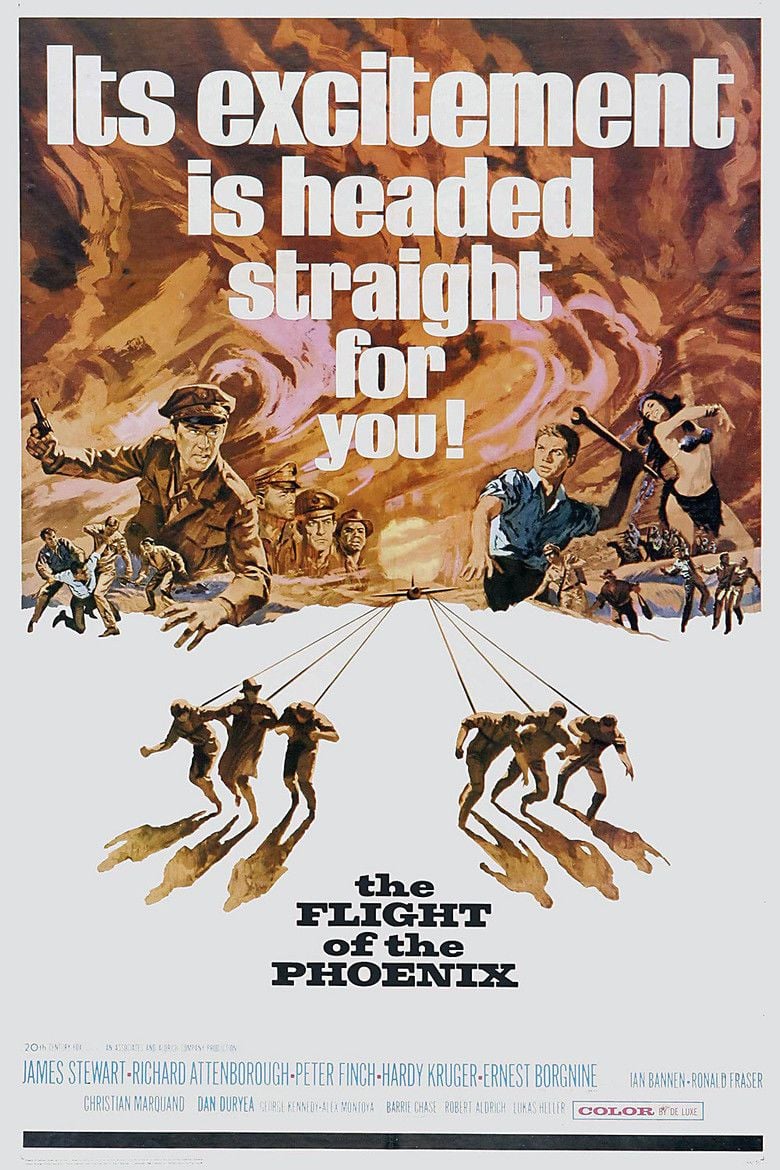 | ||||||||||||||||||||||||||||||||||
Release date December 15, 1965 (1965-12-15) Cast (Capt. Frank Towns), (Lew Moran), (Capt. Harris), (Heinrich Dorfmann), (Trucker Cobb), (Crow) Similar movies Cast Away , Independence Day , The Grey , Alive , The Expendables 2 , Non-Stop Tagline Theirs was the triumph - yours, the excitement! | ||||||||||||||||||||||||||||||||||
The flight of the phoenix 1965 trailer
The Flight of the Phoenix is a 1965 American drama film starring James Stewart, produced and directed by Robert Aldrich, and based on the 1964 novel The Flight of the Phoenix by Elleston Trevor. The story describes several men struggling to survive their aircraft's emergency landing in the Sahara Desert, and stars Richard Attenborough, Peter Finch, Hardy Krüger and Ernest Borgnine. The ensemble cast includes Ian Bannen, Ronald Fraser, Christian Marquand, Dan Duryea and George Kennedy as other passengers on the aircraft.
Contents
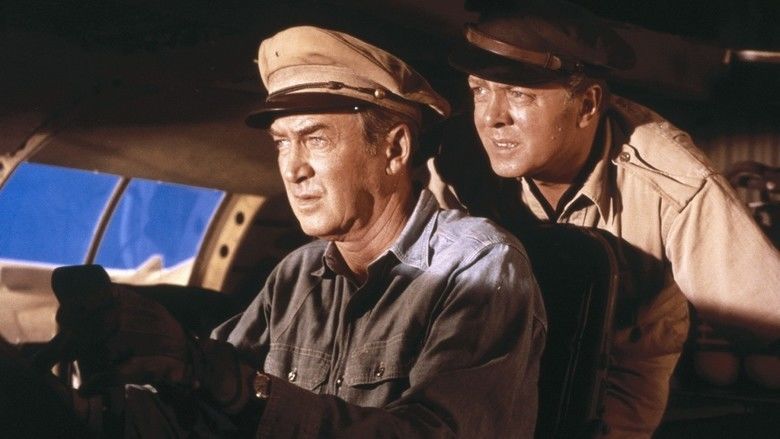
Though the film was a failure at the box office, it has since gained a cult following.
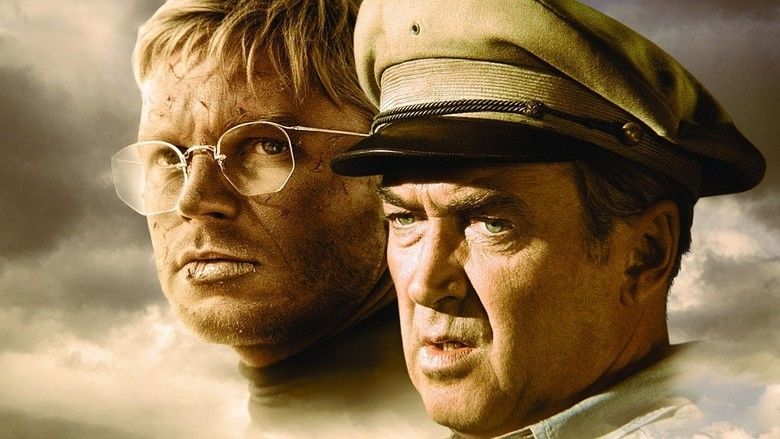
Plot

Frank Towns (James Stewart) is the pilot of a twin-engine Fairchild C-82 Packet cargo plane flying from Jaghbub to Benghazi in Libya. Lew Moran (Richard Attenborough) is the navigator while the passengers are Capt. Harris (Peter Finch) and Sgt. Watson (Ronald Fraser) of the British Army; Dr. Renaud (Christian Marquand), a physician; Heinrich Dorfmann (Hardy Krüger), a German aeronautical engineer; Mr. Standish (Dan Duryea), an oil company accountant; and several oil workers that include Trucker Cobb (Ernest Borgnine), a mentally-disturbed foreman; Ratbags Crow (Ian Bannen), a mean-spirited, sardonic Scot; Carlos (Alex Montoya) and his pet monkey; and Gabriel (Gabriele Tinti). A sudden sandstorm disables the engines, forcing Towns to crash-land in the desert. As the aircraft careens to a stop, several oil drums and oil drilling tools break loose and severely injure Gabriel's leg. Two other workers are killed.

With all onboard communications equipment rendered inoperable, the survivors are forced to wait to be rescued, but the storm has blown them too far off-course to be found. Although they have a large quantity of dates for food, they calculate their water will last for only ten to fifteen days, provided they avoid physical exertion. Harris and Carlos attempt to walk to an oasis. Carlos leaves his monkey behind with the men. Harris and Towns refuse to let Cobb go along, but Cobb defiantly follows and dies. Days later, Harris returns to the crash site alone and barely alive.

Meanwhile, Dorfmann has been working on a radical idea: He believes they can build a new aircraft from the wreckage. The C-82 has twin booms extending rearwards from each engine and connected by the horizontal stabilizer. Dorfmann's plan is to attach the outer panel of the right wing to the left engine, left boom and left wing outer panel, discarding the center fuselage and both inner wing panels of the aircraft, having the passengers traveling on top of the wings. Harris and Moran believe he is either joking or delusional. The argument is complicated by a personality clash between Towns, who is a proud old traditionalist aviator, and Dorfmann, a young, equally-proud technician. Moran, a good-natured man suffering from alcoholism, struggles to keep the peace.
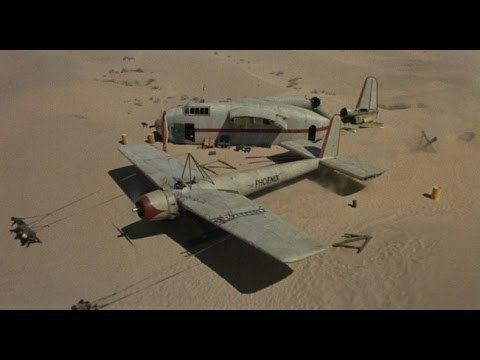
Although Towns is resistant, Renaud points out that activity and any hope will keep the men's morale up, and so Towns agrees with the plan. Dorfmann supervises the plane's reconstruction, while Towns remains doubtful. During the work, Gabriel commits suicide by slitting his wrist, and the men are so depressed by the loss that they contemplate giving up the new plane's construction. Towns discovers that Dorfmann has taken extra rations of water, who explains that he alone has been working continuously. However, Dorfmann promises to not do so again if they all work equally hard. Moran talks Towns into resuming work on the aircraft.

When the new aircraft is almost complete, Standish labels it "The Phoenix" after the mythical bird that is reborn from its ashes. Any good mood, however, is quashed when Harris and Renaud are murdered by a band of native raiders that the pair contacted for help while the rest of the crew and the aircraft remained hidden. Additionally, Towns and Moran learn that Dorfmann designs model aircraft rather than full-sized aircraft. Dorfmann claims that the principles are exactly the same, and that in many aspects models require much more exacting designs and can be less forgiving than full-size aircraft, but Towns and Moran are horrified at the idea of flying an aircraft made by a man who works with "toys". Without any other choice, however, Towns and Moran forge ahead with the plan and don't tell the others of their discovery.
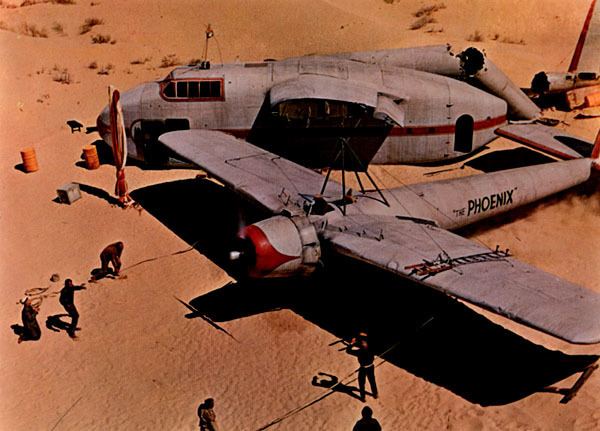
Just as the water supplies are exhausted, the Phoenix is completed. The first four startup attempts are unsuccessful, and Dorfmann panics when Towns wants to use one of the remaining starter cartridges just to clear the engine's cylinders. Dorfmann objects, but Towns ignores him and fires one cartridge with the ignition off. The next startup is successful. The men pull the Phoenix to a nearby hilltop and climb onto the wings. When Towns guns the engine, the Phoenix slides down the hill and along a lake bed before taking off. After the Phoenix lands at an oasis with a manned oil rig, the men celebrate and Towns and Dorfmann are reconciled.
Locations
Principal photography started April 26, 1965, at the 20th Century-Fox Studios and 20th Century-Fox Ranch, California. Other filming locations, simulating the desert, were Buttercup Valley, Arizona and Pilot Knob Mesa, California. The flying sequences were all filmed at Pilot Knob Mesa near Winterhaven, located in California's Imperial Valley, on the western fringes of Yuma, Arizona.
Aircraft used
In 2005, Hollywood aviation historian Simon Beck identified the aircraft used in the film:
The C-82As were from Steward-Davies Inc. at Long Beach, California, while the O-47A came from the Planes of Fame air museum in California. The R4Q-1 was purchased from Allied Aircraft of Phoenix, Arizona. The aerial camera platform was a B-25J Mitchell, N1042B, which was also used in the 1970 film Catch-22. The flying sequences were flown by Paul Mantz, co-owner of the Tallmantz Aviation, filling in for his partner Frank Tallman, who had injured his leg.
A famous racing/stunt/movie pilot and collector of warplanes, Paul Mantz was flying the Tallmantz Phoenix P-1, the machine that was "made of the wreckage", in front of the cameras on the morning of July 8, 1965. He was performing touch-and-go landings, and on one touchdown the fuselage buckled. The movie model broke apart and cartwheeled, killing Mantz and seriously injuring stuntman Bobby Rose on board.
Although principal photography was completed on August 13, 1965, in order to complete filming, a North American O-47A (N4725V) from the Planes of Fame Air Museum in Chino, California was modified and used as a flying Phoenix stand-in. With the canopy removed, a set of skids attached to the main landing gear as well as ventral fin added to the tail, it sufficed as more-or-less a visual lookalike. Filming using the O-47A was completed in October/November 1965. It appears in the last flying scenes, painted to look like the earlier Phoenix P-1.
The final production utilized a mix of footage that included the O-47A, the "cobbled-together" Phoenix and Phoenix P-1.
The final credit on the screen was, "It should be remembered that Paul Mantz...a fine man, and a brilliant flyer, gave his life in the making of this film..."
Reception
The film opened in selected theaters on December 15, 1965, with a full release in 1966. Bosley Crowther of the New York Times dismissed it as "grim and implausible," while Variety praised the film as an "often-fascinating and superlative piece of filmmaking highlighted by standout performances and touches that show producer-director at his best."
Awards
The Flight of the Phoenix was nominated for two Academy Awards: Ian Bannen for Supporting Actor and Michael Luciano for Film Editing.
References
The Flight of the Phoenix (1965 film) WikipediaThe Flight of the Phoenix (1965 film) IMDbThe Flight of the Phoenix (1965 film) Rotten TomatoesThe Flight of the Phoenix (1965 film) themoviedb.org
